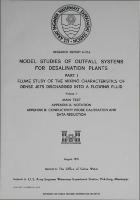Please use this identifier to cite or link to this item:
https://hdl.handle.net/11681/3249| Title: | Model studies of outfall systems for desalination plants. part 1, Flume study of the mixing characteristics of dense jets discharged into a flowing fluid. volume 1, Main text. appendix A, Notation. appendix B, Conductivity probe calibration and data reduction |
| Authors: | United States. Office of Saline Water U.S. Army Engineer Waterways Experiment Station |
| Keywords: | Effluent Desalination plants Saline water conversion plants Outfalls Ocean outfalls Estuary outfalls Estuaries Estuary Hydraulic models Waste brine Heat pollution |
| Publisher: | Hydraulics Laboratory (U.S.) Engineer Research and Development Center (U.S.) |
| Series/Report no.: | Research report (U.S. Army Engineer Waterways Experiment Station) ; H-71-2 pt.1 v.1. |
| Description: | Research Report From the Introduction: In the planning and design of plants for desalination of salt water, a major consideration is the environmentally acceptable disposal of the waste brine--a warm, dense, highly salt-laden effluent whose concentrations of copper and other metallic ions are considered to be a threat to the marine ecology. Among the several alternatives for disposal of this brine is the economically attractive one of discharging the effluent back into the ocean or estuary from which it was withdrawn. However, a means of mixing the dense liquid with the ambient fluid sufficiently to dilute the concentration of various salts to safe levels is required. The Office of Saline Water has been funding an ongoing research program through the Dow Chemical Company, in which Dr. M.A. Zeitoun of Dow Chemical Company and Professor R.O. Reid of Texas A&M University have been developing conceptual designs of desalination plant outfall systems and numerical models for prediction of their performance. The purpose of the present study was to utilize a physical model to evaluate the degree of mixing attainable through use of a diffuser located on the estuary floor or the ocean floor beyond the surf zone, from which the dense brine is discharged vertically through circular ports into a uniform and steady crosscurrent. |
| Rights: | Approved for public release; distribution is unlimited. |
| URI: | http://hdl.handle.net/11681/3249 |
| Appears in Collections: | Research Report |
Files in This Item:
| File | Description | Size | Format | |
|---|---|---|---|---|
| RR-H-71-2-Part-1-Volume-1.pdf | 11.28 MB | Adobe PDF |  View/Open |